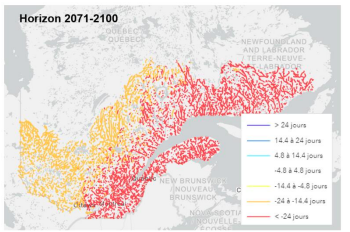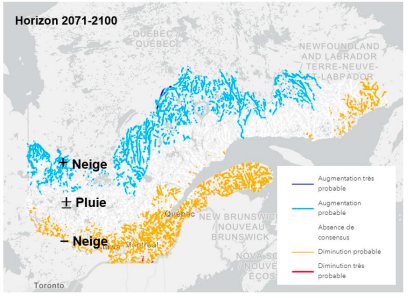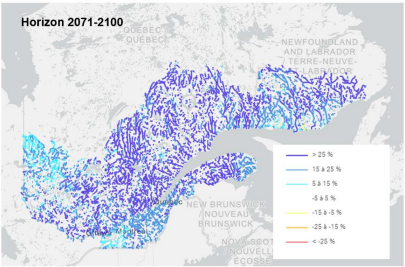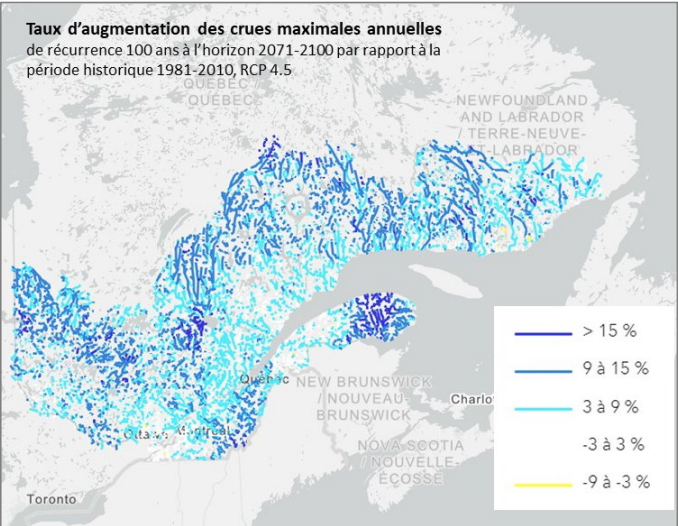High water and flooding
In the medium to long term, the effects of climate change are likely to change the occurrence and intensity of high water events in the province. Projections indicate that Quebec’s rivers will change. In winter and spring, warming temperatures and increased precipitation in the form of rainfall are likely to influence water levels. In summer and autumn, flooding is likely to be modified by increased extreme precipitation.
Several precipitation-related climate indicators are available on:
Springtime high water events
Earlier peak water levels: By 2050, the day when the peak water level occurs, i.e., the maximum flow value observed, is expected to be earlier. It could occur 9 to 14 days earlier by mid-century. By 2080, it could come 15 to 24 days earlier. This change is greater for basins further south in the province.

Figure 2 : Average day of occurrence of the maximum daily flow in winter and spring in 2071-2100 in a high GHG emission scenario (RCP 8.5) compared to the historical period 1981-2010. Red represents a change of more than 24 days, while orange represents a change of 14 to 24 days compared to normal. (From: Gouvernement du Québec, 2022)
Greater water volumes north of the St. Lawrence River Valley: Projections suggest that spring freshet volumes will be higher north of the St. Lawrence River Valley, while they could be lower in the far south of Quebec. However, a level of uncertainty persists for several rivers. The direction of change expected for these rivers varies from year to year depending on precipitation events, resulting in a lack of consensus.

Figure 3 : Direction of average flow over 14 days in winter and spring for a 20-year high water event in the future period 2071-2100 based on the RCP4.5 GHG emission scenario, compared to the historical period 1981-2010. Blue represents an increase in flow, while red and orange represent a decrease. White represents the uncertainty. (From: Gouvernemnt du Québec, 2022).
Summer and fall flooding
Climate change will likely lead to an increase in summer and fall high water events throughout Quebec. The magnitude of this increase varies depending on the time horizon considered and the greenhouse gas emission scenario used. However, current projections indicate that water volumes and peaks in summer and fall will be greater. It should be noted that high water events in the summer and fall are less often associated with flooding.

Figure 4: Maximum daily flow in summer and fall for a 20-year flood in 2071-2100 based on an RCP8.5 GHG emission scenario, compared to the historical period 1981-2010. Dark blue represents an increase of more than 25% in the maximum flow of a watercourse. (From: Gouvernement du Québec, 2022).
Winter flooding
In winter, watercourse flows are generally lower due to freeze-up. However, winter flows are likely to increase due to projected warming during this season and the resulting melting of river ice.
Extreme floods
Definition | Maximum annual flood
The maximum annual flood is the highest level of flow of a lake or watercourse in a year.
Hydroclimatic projections indicate that by the end of the century, extreme high water flow events will become more frequent and more intense over a large part of the province’s inhabited areas. While this doesn’t necessarily mean that these events will lead to flooding every year, they may increase and intensify the risk of flooding when they arise. This is especially true of the rarest high water flow events, such as those that statistically occur once every 100 or 350 years.
According to the Hydroclimatic Atlas of Southern Québec, under a moderate emission scenario (RCP4.5), annual maximum floods of the kind that recur only every 100 years could increase by 3% to over 15% by 2071-2100, compared with the historical period from 1981 to 2010. This projected increase will vary from region to region and watershed to watershed, and it’s important to consider the uncertainty associated with projections, particularly for these more extreme events.

Figure 5: Rate of increase in 100-year maximum annual floods under a moderate emission scenario (RCP4.5) by 2071-2100, compared with the period from 1981 to 2100.